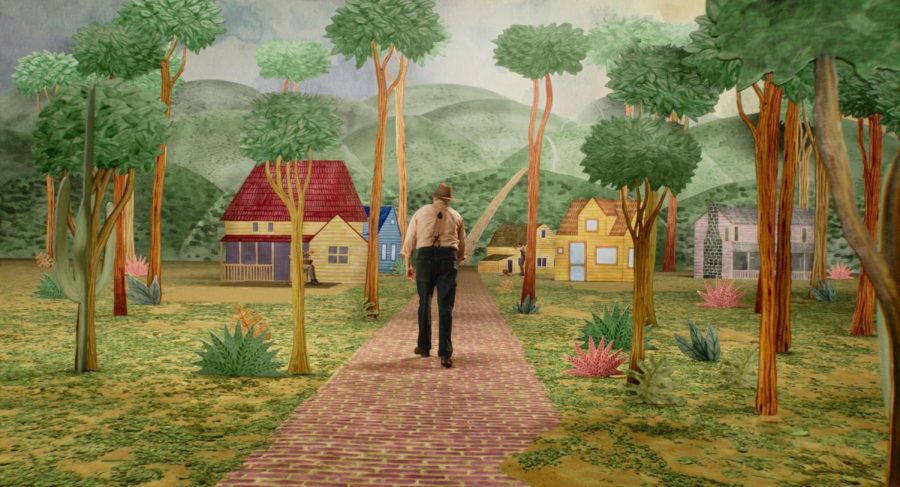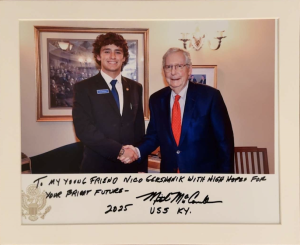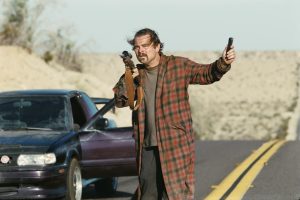Movie Review: Beau is Afraid
May 5, 2023
Ari Aster‚Äôs newest movie ‚ÄúBeau Is Afraid‚Äù may just be one of the best movies of the year‚Äîit takes the standard A24 film and elevates it to a new level of visual art, creating an enticing experience for most film fanatics like myself.¬Ý
This three hour-long epic takes the audience into a story where Beau (played by Joaquin Phoenix), a classic case of arrested development, is on a journey back home to see his mother. Aster takes the audience through dozens of tangents along Beau‚Äôs journey where his struggle with growing anxiety manifested as real world obstacles¬Ý striking him left and right. Overall, ‚ÄúBeau is Afraid‚Äù is a beautifully chaotic film about the absurdity of fear.
Spoilers ahead
A fever dream of a movie– it’s beyond any standard, linear storyline. Aster throws the audience into the Gotham-like city where Beau is living and the first few scenes can be compared to that of a chaotic multiplayer video game. The visuals throughout the movie were dynamic, especially when the movie shifts from regular live action to a mix of stop animation and play production sets three-quarters into the film.
A technique Aster makes use of throughout the film is placing the audience in the point of view of a character in a scene, usually Beau. In a few scenes, the movie screen shows the world through Beau‚Äôs gaze as the camera awkwardly moves and looks around. Besides actively shooting from the point of view of Beau, he‚Äôs the one character (out of the large cast) whom the audience is constantly following. The audience might also notice that there is very rarely a pause in the action. Something is usually always happening. This throws the audience deeper into Beau’s frantic world and makes the movie a lot more interactive since the audience feels like they get to play a character in the film.¬Ý
While the characters were in no way likable, they were interesting and utterly absurd. The movie starts with Beau speaking to his therapist (played by Stephen McKinley Henderson, whom many A24 fans might recognize as the priest from ‚ÄúLady Bird‚Äù). From over the shoulder of the therapist is where the audience views Beau who seems small in comparison. Straight from the beginning, this sets the tone for what we should expect from Beau who, even though a fully grown adult, seems to be stunted in his emotional maturity after having been sheltered all his life by¬Ý his mother, Mona, and the people around him. In fact, most of the movie plays out as if Beau is a child who has no choice on the direction of his life.
This brings me to his relationship with his mother which I found to be one of the more interesting aspects of the movie. Beau’s mother, Mona Wassermann, is a business tycoon who got rich by starting her business, MW Industries. While the story behind Mona’s profession isn’t explicitly stated during the film, it undoubtedly forms the basis of Beau’s character. Growing up with a mother who specializes in safety makes it more clear why Beau seems to be afraid of so many things when the possibility of something not being safe is very much present in life, especially in one where he seemingly has no free will. The MW Industries logo appears in both the beginning and end credits, implying that Mona’s influence on Beau is much greater than anyone might initially think.
Mona’s manipulation of her son really makes him who he is. All his life, Mona told him that the most important thing was to find your perfect match (highlighted by the cruise ship scenes). Growing up, it’s reasonable to think that Beau thought his mom could have been his “perfect match” (the movie does explore somewhat Freudian themes) so when she disappointedly hangs up on him from the beginning of the movie, he loses the most important thing in his life. This point when he loses his security is when his paranoia really begins intensifying.
Through Mona, the movie urges you to interact with its universe. With dozens of details in the set, direction, and storytelling to indulge in, observant viewers might note that Mona’s corporation is credited as a production company at the beginning and end of the movie. Those curious enough to look into it will see that MW Corporations has its own official website, Instagram account, and Linked-In which interact with fans.
So what is Aster trying to tell us with his three hour odyssey? For an audience that enjoys trying to find meaning in art, they‚Äôll have an interesting time trying to decipher this film. Above all, this was undoubtedly a movie about fear. Is it any coincidence that Beau sounds a lot like ‚Äúboo‚Äù?¬Ý
Nearly every fear was depicted in this movie. From arachnophobia in the very beginning when Beau comes home to find a warning on his door about a spider infestation to the fear of the monster in the attic or disappointing a loved one, Beau goes through them all: this journey is absurd to say the least. In the end, however, perhaps being afraid is absurd and it is something which the viewer should embrace. Most fears are irrational so why should a movie about fears make any sense at all?¬Ý There‚Äôs also beauty in this kind of horror, something which Aster is no stranger to.
Viewers should go into the theater expecting absolutely nothing from this film and leave with dozens of questions. The best kinds of movies make you think and stay with you long until they’re over–Aster is undoubtedly a master at his craft.



















Max G • May 7, 2023 at 10:09 pm
Excellent review. Very insightful and thoughtful. I’m excited to see the movie with an open mind.
Noah • May 5, 2023 at 9:29 pm
Wow! Great review! Really helped me understand the movie “Beau is Afraid!”.